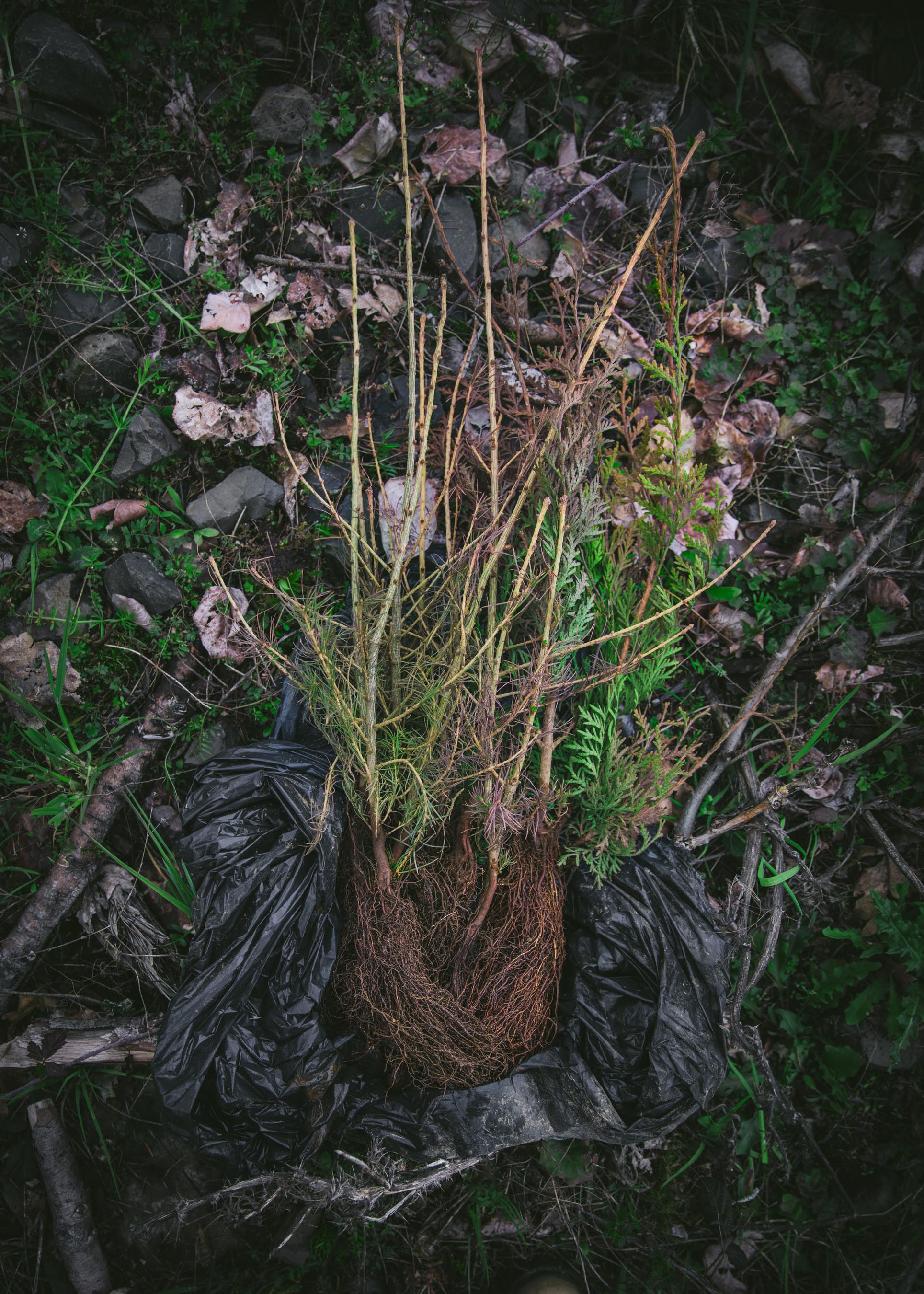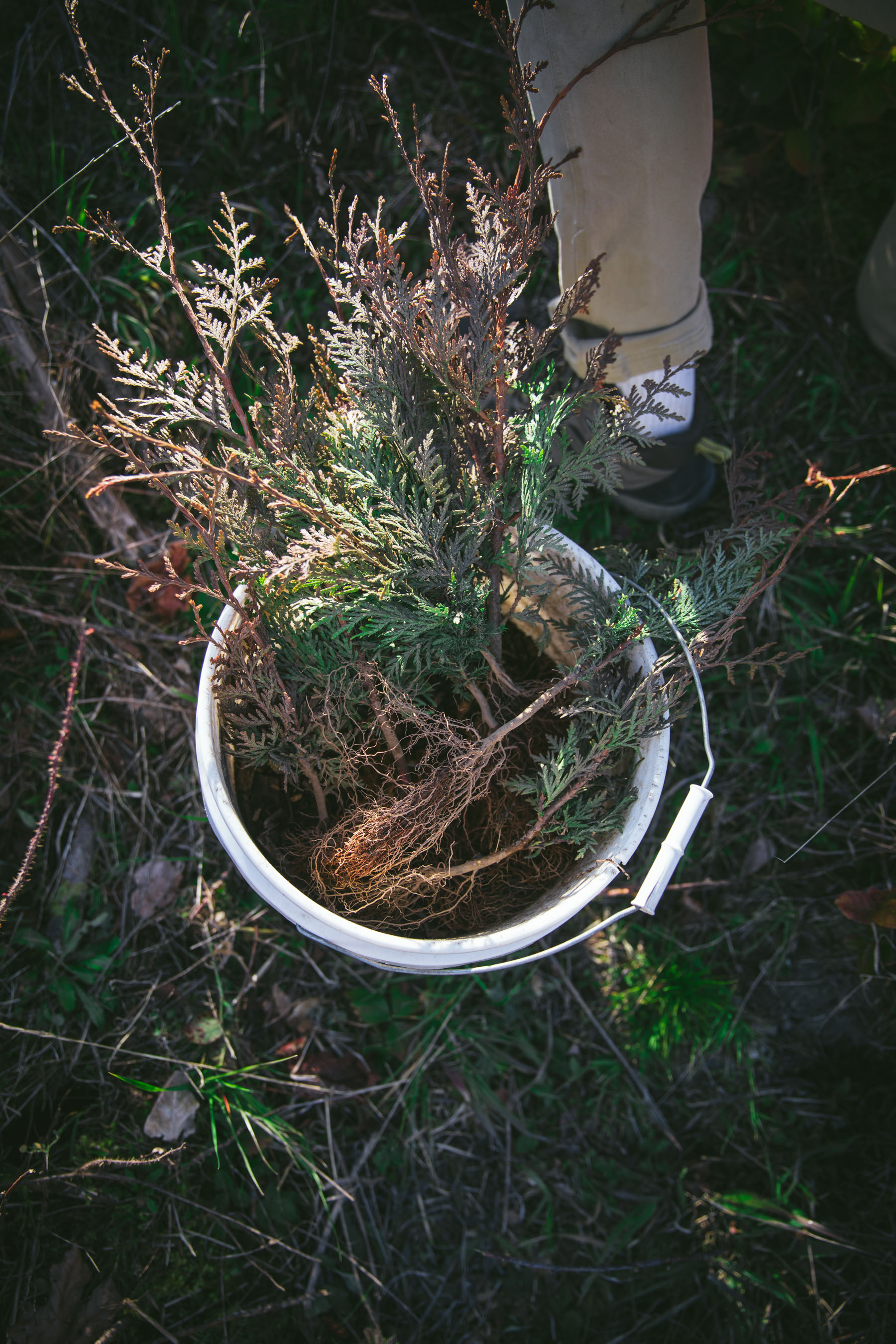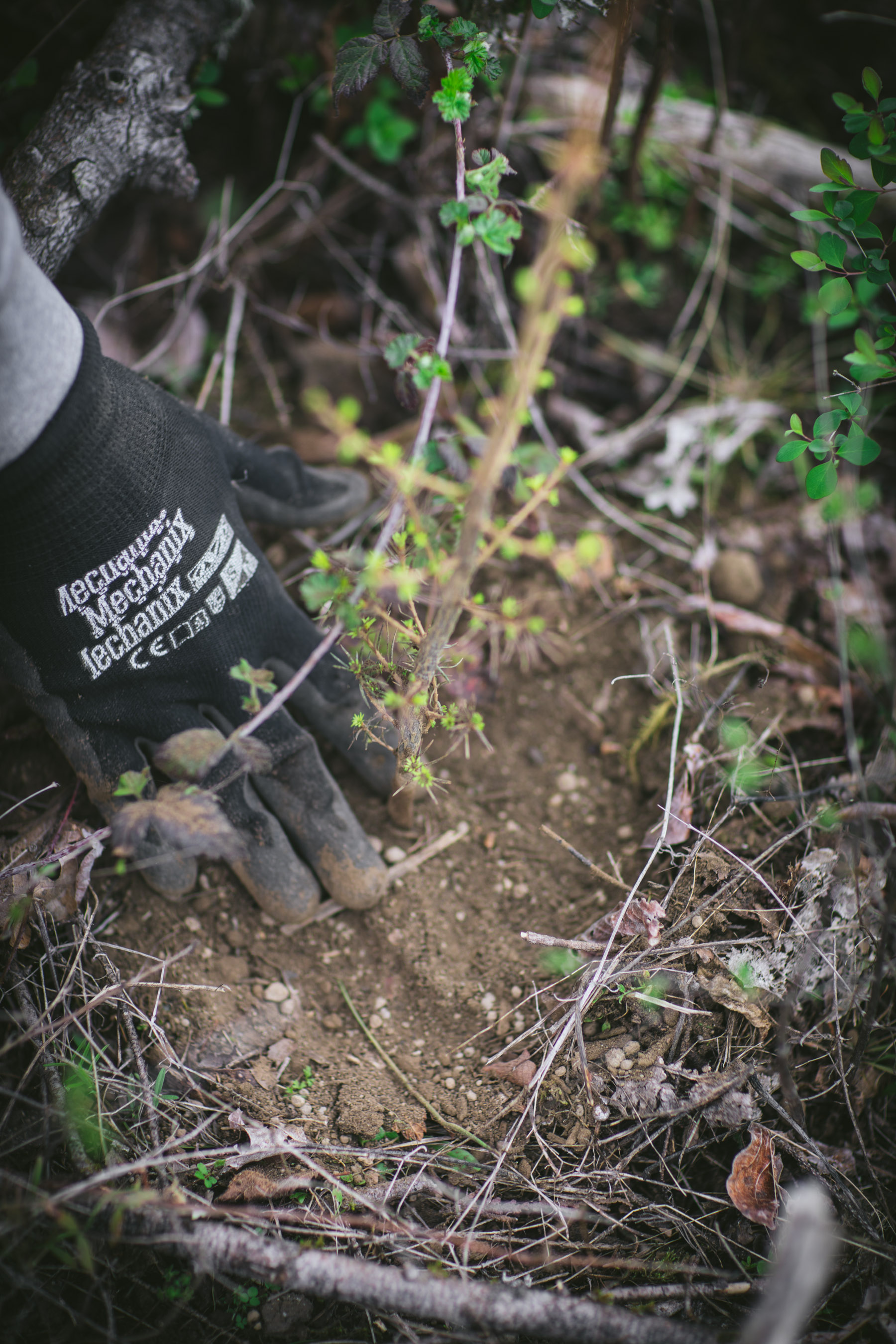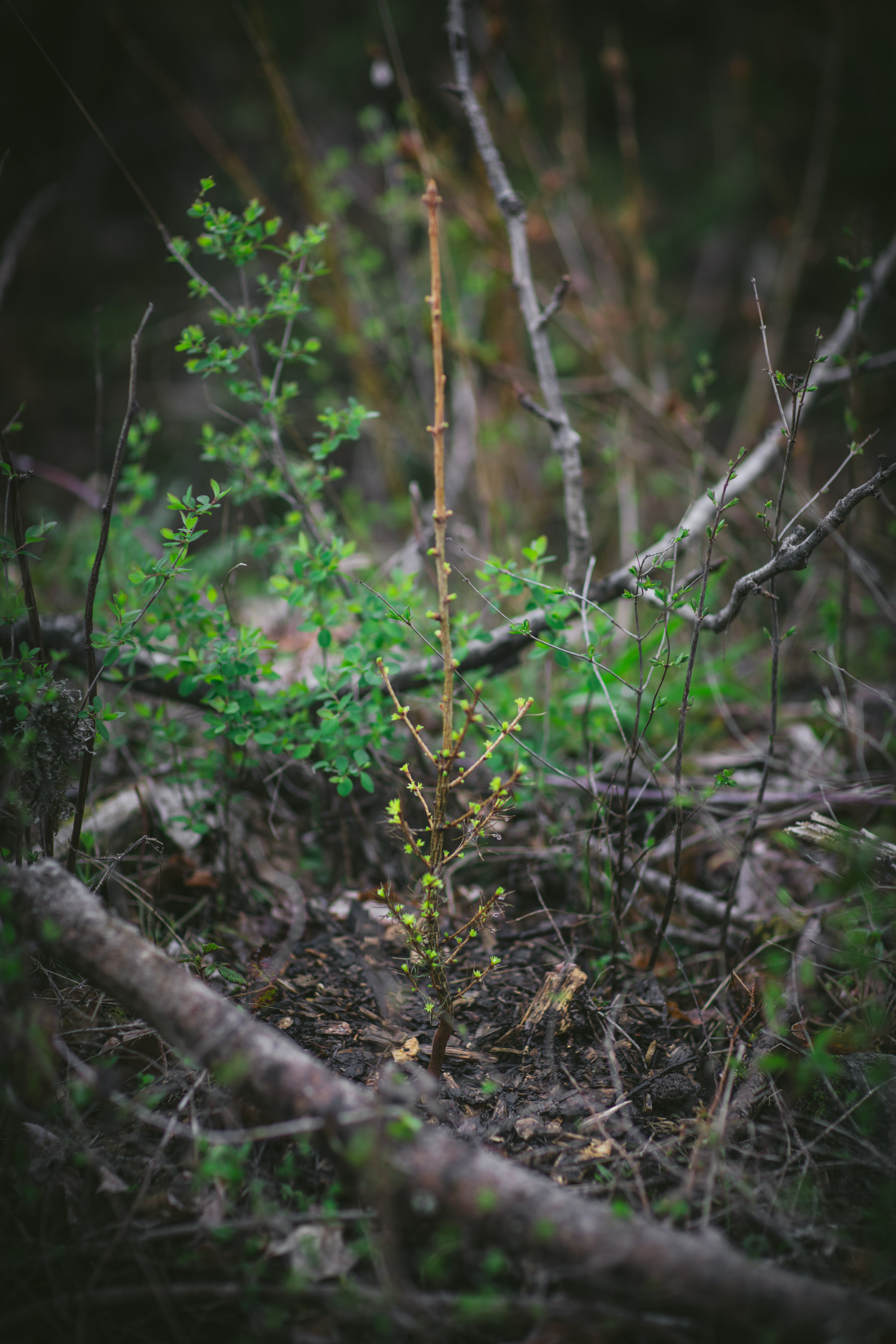
Back in early March, Jeremy and I gathered at the homestead with a few friends. Over the winter I’d pre-ordered 80 young trees (aka saplings) making up 6 different tree varieties native to the Pacific northwest, and that spring morning we picked them up, loaded them into the cab of the truck, and headed to the homestead. Over the next few hours we planted over 60 trees altogether—it was a LOT of intense physical labor that entailed trekking through blackberry brambles and searching for soft spots in the ground (which as you guys know from this post, was very compacted from the logging process), but at the end of the day we were the best kind of sore, and it was one of the most rewarding things I’ve ever done. It was also the second-to-last time we saw our friends in-person before quarantine started, and I’m so grateful we were able to share this amazing day together out in the sun beforehand.

Jeremy and I went back a few days later and planted the last few saplings, and we’ve been checking on them every time we’ve visited the homestead since. It’s been so exciting to watch the new growth come out; seeing that and knowing that they’ll (hopefully) be around much longer than we ever will is a really special and rewarding feeling. I like to imagine what they’ll look like in 10 and 20 years’ time, when they’re towering tall over us and giving us a beautiful forest canopy to gather under again.
Some fun facts about trees
- Without forests on the coast, anywhere over 500 miles from a coastline would be a barren desert. The condensation that forms on the needles + leaves of trees from the ocean spray eventually evaporates and this is what creates clouds. Without clouds, there would be no rain. Without trees, there would be no clouds. This is why combatting de-forestation is so important.
- Trees communicate through an underground network of mycelium (aka fungus) that grows around tree roots. Trees create electronic impulses through the mycelium network to communicate with nearby trees, much like the neuron pathways in the human brain.
- They also communicate through scent. When attacked by predators/pests, some trees flood their bark with toxins and also emit a mixture of scent compounds that warns nearby trees of the attack, so the neighboring trees can preemptively fill their bark with toxins as well.
- Trees also exchange nutrients with one another through their mycelium network, to help keep the young trees they’ve created around them healthy. A beech tree stump was found in a forest in Germany that was from a tree cut down over 400 years ago, and yet it was still alive, thanks to the support of the tall trees around it sharing their nutrients with it for hundreds of years.
There’s a lot more than meets the eye when it comes to trees, and I *highly* recommend reading The Hidden Life of Trees by Peter Wohlleben if you have the time. It’s really easy to read, and paints a fascinating picture of the intelligence these creatures have. Just because they’re slow-growing doesn’t mean there’s not a lot going on in there under the bark + earth. I like to think of them as Peter Jackson depicted them in Lord of the Rings 🙂
 When it comes to planting trees, using very young bare-root or plug saplings is *MUCH* better than buying a several-foot tall tree from a container. There’s a pile of bare-root trees in the very first photo of this post, if you’re curious about their appearance. When you plant a bare-root tree, the tree ends up being much hardier and more likely to survive for a very long time because it’s raised from a young age in a normal growing environment, and gets used to + builds up defenses against the natural elements like snow, drought, pests, etc. When you buy a tree that’s in a pot, it’s been pampered at a nursery it’s whole life, and is used to the nursery environment. It hasn’t developed the defenses to survive in the wild, and will likely die unless you’re able to give it weekly pampering for several years until it’s established.
When it comes to planting trees, using very young bare-root or plug saplings is *MUCH* better than buying a several-foot tall tree from a container. There’s a pile of bare-root trees in the very first photo of this post, if you’re curious about their appearance. When you plant a bare-root tree, the tree ends up being much hardier and more likely to survive for a very long time because it’s raised from a young age in a normal growing environment, and gets used to + builds up defenses against the natural elements like snow, drought, pests, etc. When you buy a tree that’s in a pot, it’s been pampered at a nursery it’s whole life, and is used to the nursery environment. It hasn’t developed the defenses to survive in the wild, and will likely die unless you’re able to give it weekly pampering for several years until it’s established.
If you’re worried about the growth rate, bare root trees usually out-grow their root-bound container transplant counterparts in a couple years. Because trees grown in containers have the roots so tightly packed together, they are a lot more at-risk for disease and the roots don’t grow as quickly as the young bare-root trees do. This means the tree isn’t able to get as much nutrients and water from the soil, which slows down its growth considerably, and make it more at risk for drying out in the summertime.
You can order bare-root trees online to be shipped to your house. They should be planted either in the spring or in the fall, when natural rainfall will help them stay hydrated. But if you’re able to water them, (like if you plant them in your backyard), that will help them, too! I put together a guide on how to plant a tree below, it’s a great activity to do outdoors with the people you’re quarantining with, or solo. It feels so good to do something that you know will benefit the earth and all its life-forms, including humans, for hundreds of years. Enjoy it my friends!

How to Plant a Tree
This will take you through how to plant a bare-root tree sapling, which should ideally be done in spring or early autumn, to give the tree's root system time to establish itself before drought or frost hits.
If you're going to plant a lot of trees, I recommend investing in a dibble tree-planting tool. If you're just doing a couple or a handful, using a hand trowel (aka small shovel) will work just fine! I also have step-by-step photos of this process below these instructions, too, so feel free to peek at them for guidance 🙂
- 1 Bare-root sapling
- 1 dibble tree-planting tool or hand trowel (aka small shovel)
- Mulch (like bark chips)
- Compost
- Watering can filled with water
- Gloves (not totally necessary but makes the process cleaner)
Choose the Planting Site
-
Do some basic research on the variety of tree you're planting, and choose a planting site that fits the requirements of your tree (aka full sun, or partial shade, etc). Spending 5 minutes to choose the right planting site greatly increases the long-term health of your tree.
Mix Native Soil with Compost
-
Dig up some soil in the general area where you will be planting the tree. We will refer to this as 'native soil'. In a bucket, mix together 3 parts native soil with 1 part compost. Set it aside.
Dig the Hole
-
If you have a hand trowel, dig a hole that's about 4 inches in diameter and deep enough so that the tree's roots don't touch the bottom.
-
If you have a dibble, insert it into the ground at a 60-degree angle up until the hilt of the dibble. Push it forward to a 90-degree angle to create your hole, then remove the dibble. Make sure your hole is deep enough so that the tree's roots don't touch the bottom.
Hold the Tree
-
Hold the tree by the stem over the center of the hole, and make sure the area with roots is *just* below the soil line around it. You don't want any roots above the soil line, otherwise the tree will dry out. You also don't want any branches below the soil line, otherwise the tree could rot.
-
Now look at the bottom of the hole. If the root are dangling straight down into the hole, that's great. If the roots are touching the bottom of the hole, or caught on the side of the hole and forming a 'J' shape, take the tree out and deepen or widen the hole as-needed, and dangle the tree in the hole again until the roots hang straight down and don't get caught on the sides.
Fill the Hole
-
While holding the tree in place (still making sure the roots are *just* below the soil line) with one hand, use the other to start filling in the hole with the native soil and compost mixture.
-
Fill until the soil in the hole is level with the surrounding soil line. Pat the soil gently around the tree with the flats of your palms. If it sinks a bit, sprinkle some more native soil and compost mixture around the tree to make its level even with the surrounding soil line again.
Water the Tree
-
Use more of the native soil and compost mixture to make a 1-inch high mounded circular border around the tree, about 3 inches away from the base of the tree. This will help the water stay around the tree when you water it, rather than just flowing away.
-
Water the tree with your watering can. Wait a few seconds for the water to drain, then water it again. Repeat one more time.
Add the Mulch
-
Sprinkle a a 1-inch thick layer of mulch around the base of the tree, going out 4 to 6 inches in diameter around the tree.
-
Use your pointer finger to nudge any mulch that's touching the tree's stem about 1 cm away. Ideally, you don't want a lot of mulch actually physically touching the tree because that can cause fungal rot, but you do want a good amount of mulch around the tree.
Water Again
-
Now that the mulch is there, water it one more time. And that's it! You've successfully planted a tree!
Maintenance
-
Every tree has different hardiness levels, so do some research on the variety you're planting and follow the watering guidelines for that variety.












0 comments